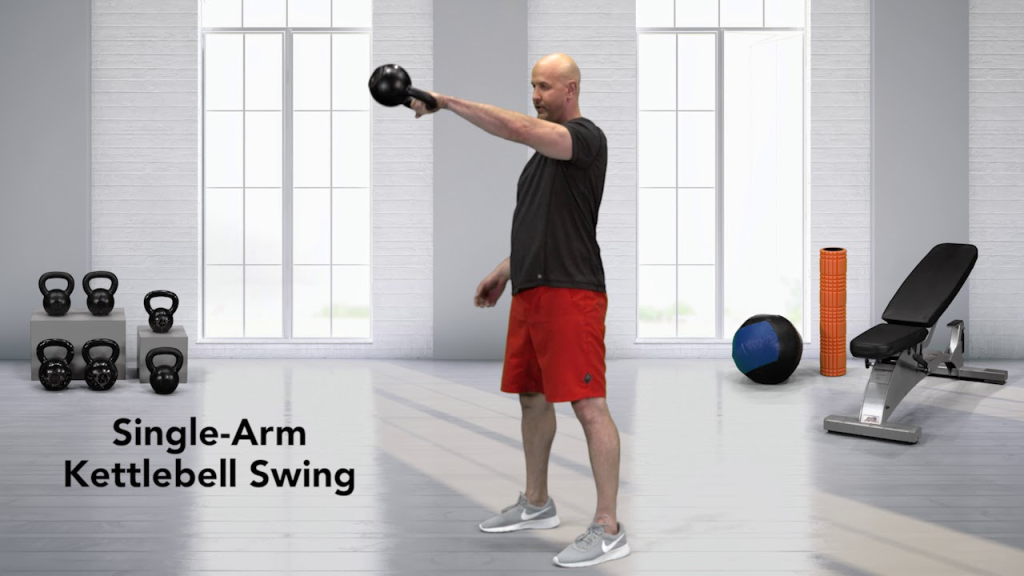Performing 100 kettlebell swings a day has become a popular fitness challenge for people looking to improve overall strength, burn fat, and boost cardiovascular endurance without spending hours in the gym. While the concept sounds simple — just grab a kettlebell and swing it 100 times – the real power of this workout lies in consistency, proper form, and progression. Whether you’re an athlete, a busy professional, or someone just starting a fitness journey, this minimalist routine can transform your body and performance when done correctly.
The Power of the Kettlebell Swing
The kettlebell swing is a dynamic, full-body movement that builds strength, endurance, and coordination. It combines elements of strength training and cardiovascular exercise in one motion, making it one of the most efficient workouts available. When done properly, it targets the posterior chain — the glutes, hamstrings, and lower back — while engaging the core and upper body for stability and control.
The movement also trains the body to hinge at the hips, one of the most fundamental and functional patterns for human movement. This makes kettlebell swings not just a workout tool but a way to improve posture, athletic performance, and day-to-day mobility.
Benefits of Doing 100 Kettlebell Swings a Day
Full-Body Engagement
Unlike isolated exercises, kettlebell swings work multiple major muscle groups simultaneously. Each repetition activates the glutes, quads, hamstrings, lower back, shoulders, and core. The continuous hip-hinge motion reinforces strong and balanced movement patterns, promoting muscular symmetry and power. Performing 100 swings daily trains these muscles consistently, helping you build lean muscle mass and improve strength endurance.
Cardiovascular Conditioning
Kettlebell swings are deceptively intense. The explosive hip drive and fast rhythm elevate your heart rate within seconds, delivering an excellent cardiovascular workout. Regularly performing 100 swings can improve heart health, increase lung capacity, and enhance overall endurance. This makes it a powerful alternative for those who prefer functional movement over traditional cardio like running or cycling.
Fat Loss and Metabolic Boost
Kettlebell training combines resistance and aerobic work, creating a potent fat-burning effect. The intensity of 100 daily swings raises your metabolism both during and after your workout. Thanks to the afterburn effect, or excess post-exercise oxygen consumption (EPOC), your body continues to burn calories even hours after finishing. Over time, this contributes to noticeable reductions in body fat and improved muscle definition, particularly around the core and lower body.
Core Strength and Posture
The kettlebell swing demands a strong and stable core. Each swing challenges your abdominals and lower back to resist movement and protect your spine. Over weeks of consistent training, this leads to improved core stability, better posture, and a reduced risk of back pain. For individuals who spend long hours sitting, kettlebell swings can counteract the effects of a sedentary lifestyle by strengthening the posterior chain and opening tight hip flexors.
Functional Strength and Mobility
Beyond aesthetics, kettlebell swings enhance real-world strength and athleticism. The movement pattern mimics functional motions like lifting, bending, and jumping. Improved hip drive and posterior chain strength translate directly into better sprinting power, jumping ability, and daily activity efficiency. Whether you are carrying groceries or playing sports, the benefits are immediately noticeable.
Time Efficiency
A set of 100 swings can take as little as seven to ten minutes. This makes it one of the most time-efficient ways to work out, ideal for people with busy schedules. Despite its brevity, the session packs both strength and cardio benefits, providing results that rival longer, more complex routines.
Hormonal and Mental Benefits
Kettlebell swings naturally stimulate the release of growth hormone and testosterone, aiding in muscle recovery and fat metabolism. The exercise also provides a psychological boost — the rhythmic, powerful movement releases endorphins, helping reduce stress and improve focus. Completing 100 swings can leave you feeling both physically and mentally energized.
How to Perform the Perfect Kettlebell Swing
Proper form is critical for effectiveness and safety. The swing should be driven by the hips, not the arms or shoulders.
- Start Position: Stand with feet slightly wider than shoulder-width apart. Place the kettlebell about a foot in front of you.
- Grip and Setup: Hinge at the hips, keep your back flat, bend your knees slightly, and grasp the handle with both hands.
- Hike: Pull the kettlebell back between your legs as if hiking a football, keeping it close to your groin.
- Drive: Forcefully extend your hips forward, squeezing your glutes and using the momentum to swing the kettlebell to chest level.
- Control: Let the kettlebell swing back down naturally as you hinge your hips again.
- Repeat: Maintain a steady rhythm without rounding your back or lifting with your arms.
How to Structure 100 Swings a Day
For most people, performing 100 kettlebell swings at once may be too challenging at first. Start with smaller sets and build up gradually.
Example progression:
- Beginners can start with 5 sets of 20 swings, resting 30 to 60 seconds between sets.
- Intermediate lifters may perform 4 sets of 25 swings or 2 sets of 50 swings.
- Advanced athletes can complete all 100 swings in a single unbroken set or add them into a circuit workout.
The key is consistency and form. Over time, as strength and endurance improve, you can experiment with heavier kettlebells or shorter rest periods for greater intensity.

Kettlebell Weight Guide
Selecting the right kettlebell weight is essential for safety and effectiveness. Beginners should use a moderate load that allows for control without compromising form.
- Women: Start with 8–12 kg (18–26 lbs).
- Men: Start with 12–20 kg (26–44 lbs).
Once your technique improves, you can gradually increase the weight to continue challenging your muscles and cardiovascular system.
Potential Risks and How to Avoid Injury
While kettlebell swings are safe when executed correctly, poor form can lead to strain, especially on the lower back and shoulders. Common mistakes include overusing the arms, rounding the spine, or squatting instead of hinging.
To minimize risk:
- Always warm up with dynamic stretches.
- Keep your core engaged throughout the movement.
- Hinge at the hips rather than bending your knees excessively.
- Stop immediately if you feel pain or discomfort in your back or joints.
If you’re unsure of your form, consider working with a certified trainer or recording your swing to self-assess technique.
Realistic Results From 100 Kettlebell Swings a Day
People who commit to 100 swings daily often notice improvements within weeks. While results vary depending on diet, experience, and intensity, many report increased muscle tone, better stamina, and noticeable fat loss.
After a month, you can expect:
- Enhanced cardiovascular fitness and endurance.
- Stronger glutes, hamstrings, and core.
- Improved posture and balance.
- Visible changes in body composition, especially reduced belly fat.
It’s important to remember that kettlebell swings alone won’t transform your body overnight. Combining the routine with a balanced diet and adequate recovery yields the best results.
Who Should Try the 100 Kettlebell Swings a Day Challenge
This challenge suits individuals looking for a simple yet powerful workout that fits into a busy lifestyle. It’s especially beneficial for:
- People wanting to lose fat and gain strength.
- Athletes seeking functional conditioning.
- Beginners building foundational fitness.
- Desk workers looking to counteract sedentary habits.
However, those with existing back or shoulder injuries should consult a medical professional before beginning the routine.
Tips for Long-Term Success
- Prioritize Form Over Speed: A few perfect swings are more effective than sloppy repetitions.
- Track Your Progress: Record your sets, rest times, and kettlebell weight to monitor improvement.
- Add Variety: Once your body adapts, mix in other movements like goblet squats, Turkish get-ups, or kettlebell cleans.
- Stay Consistent: The benefits compound with daily practice. Missing a day occasionally is fine, but aim for regularity.
- Combine With Nutrition: Pair your training with a nutrient-rich, balanced diet to maximize fat loss and recovery.
Conclusion
Committing to 100 kettlebell swings a day is a simple yet transformative approach to fitness. In less than ten minutes, you can strengthen your entire body, burn fat, and improve your cardiovascular health. The key lies in discipline, progression, and form. When performed consistently and safely, this compact routine delivers remarkable results — making it one of the most efficient workouts you can integrate into your daily life.
Whether your goal is weight loss, performance enhancement, or general fitness, kettlebell swings offer a dynamic and sustainable path to success.

Frequently Asked Questions (FAQ)
What happens if I do 100 kettlebell swings every day?
You’ll improve strength, endurance, and muscle tone while burning significant calories. Over time, you may notice better posture, reduced body fat, and stronger glutes and core muscles.
Is 100 kettlebell swings enough for a workout?
For most people, yes. When performed with proper intensity and weight, 100 swings can provide a full-body workout. However, combining it with other exercises or resistance training can enhance results.
Can kettlebell swings replace cardio?
Kettlebell swings offer similar cardiovascular benefits to running or cycling, especially when done at a high pace. They’re an excellent option for improving endurance while building strength.
Do kettlebell swings build muscle?
Yes. They help develop lean muscle, particularly in the glutes, hamstrings, lower back, and core. The movement primarily enhances power and endurance rather than bulk muscle size.
How many calories do 100 kettlebell swings burn?
Depending on weight, intensity, and rest periods, 100 swings can burn between 200 to 300 calories. The exact number varies from person to person.
Can beginners do 100 kettlebell swings a day?
Beginners should start slowly. Begin with fewer repetitions, focus on form, and increase gradually to 100 swings as strength and technique improve.
How long does it take to complete 100 kettlebell swings?
On average, the workout takes about seven to ten minutes. You can perform all swings at once or break them into smaller sets throughout the day.
Do I need rest days when doing 100 swings daily?
If you feel sore or fatigued, allow rest or active recovery days. Overtraining can lead to injury, so it’s important to listen to your body.
What weight should I use for kettlebell swings?
Women often start with 8–12 kg, while men may begin with 12–20 kg. Choose a weight that challenges you without sacrificing form.
Can kettlebell swings cause back pain?
Back pain usually results from improper form, not the exercise itself. Maintain a neutral spine, engage your core, and hinge at your hips to protect your back.



